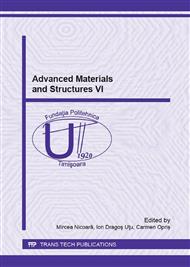[1]
X. He, F. Gu, A. Ball, A review of numerical analysis of friction stir welding, Progress in Materials Science 65 (2014) 1-66.
DOI: 10.1016/j.pmatsci.2014.03.003
Google Scholar
[2]
M. Nourani, A. S. Milani, S. Yannacopoulos, On the effect of different material constitutive equations in modeling friction stir welding, International Journal of Advances in Engineering & Technology 7 (2014) 1-20.
Google Scholar
[3]
M. Awang, Simulation of Friction Stir Spot Welding (FSSW) Process: Study of Friction Phenomena, Dissertation, College of Engineering and Mineral Resources at West Virginia University, (2007).
Google Scholar
[4]
V. Soundararajan, S. Zekovic, R. Kovacevic Thermomechanical model with adaptive boundary conditions for friction stir welding of Al 6061. International Journal of Machine Tools & Manufacture 45 (2005) 1577–1587.
DOI: 10.1016/j.ijmachtools.2005.02.008
Google Scholar
[5]
G.R. Johnson, W.H. Cook, A constitutive model and data for metals subjected to large strains, high strain rates and high temperatures, 7th International Symposium on Ballistics, Netherlands, (1983) 541–547.
Google Scholar
[6]
F. Al-Badour, M. Nesar, S. Abdelrahman, A. Bazoune, Thermo-mechanical finite element model of friction stir welding of dissimilar alloys, International Journal of Advanced Manufacturing Technology 72 (2014) 607-617.
DOI: 10.1007/s00170-014-5680-3
Google Scholar
[7]
M. Assidi, L. Fourment, S. Guerdoux, T. Nelson, Friction model for friction stir welding process simulation: Calibrations from welding experiments, International Journal of Machine Tools & Manufacture 50 (2010) 143-155.
DOI: 10.1016/j.ijmachtools.2009.11.008
Google Scholar
[8]
Z. Zhang, J.T. Chen, The simulation of material behaviors in friction stir welding process by using rate-dependent constitutive model, Journal of Materials Science 43 (2008) 222-232.
DOI: 10.1007/s10853-007-2129-1
Google Scholar
[9]
M. Riahi, H. Nazari, Analysis of transient temperature and residual thermal stresses in friction stir welding of aluminum alloy, International Journal of Advanced Manufacturing Technology 55 (2011) 143-152.
DOI: 10.1007/s00170-010-3038-z
Google Scholar
[10]
ABAQUS analysis user's manual, version 6. 7, ABAQUS Incorporation (2007).
Google Scholar


